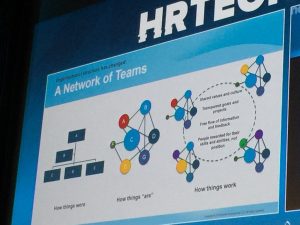There is much confusion about when to ask for flexible working in the hiring process. Karen Mattison MBE Joint CEO of Timewise writing about requests for flexible hours in the Guardian complains about the lack of transparency in recruitment processes and how asking for flex conditions as a candidate is “like playing poker.” She maintains that frequently the only jobs open for flexible or part-time working are more junior ones.
“Because there is a fundamental problem with how jobs are designed and how modern businesses recruit and retain talent. This growing mismatch between what candidates want and need and how businesses recruit is leaving skilled people trapped in roles they are overqualified for and navigating a jobs market where they don’t know the rules.”
She then goes on to say:
“Nine out of 10 managers say they would consider offering flexible working to hire the best person, yet none of them say that at the recruitment stage. Why?”
Need vs want
I am someone who genuinely believes that with today’s advanced technology there is no reason why flexible conditions can’t be offered more widely. Richard Branson tweeted:
“Give people the freedom of where to work & they will excel.”
Although flexible working conditions are on the increase, many companies don’t offer flexible conditions openly, but do give consideration to flex requests from successful candidates. This is challenging for the job seeker. When they are applying for a job they have to make a clear distinction between “needing” to ask for flexible working and “wanting” those conditions. Very often the way this works is a function of the individual, not the function of the role.
Flex business models
An increasing number of companies are shifting to different business models to accommodate the demands of a 21st century workforce especially during a global pandemic. These companies will state clearly that flexible working, part-time working, and job sharing are possibilities and are part of their company culture. This could be in the ad itself or on the web site. Lists of such companies are being widely collated particularly in the press. There are also social proofing sites such as Glassdoor, Fairy Godboss and InherSight which give employee evaluations of working conditions, including flexible conditions.
So it makes sense if a job seeker “needs” flexible working, then they should target companies which meet that specific requirement. This has to be distinguished from candidates who “want” flexible working as a life style choice.
Job structure
Jobs are usually created to be full-time and if they are not, then they will be clearly assigned a part-time status. They will often be stand alone or project type roles and rarely senior ones vital to the bottom line of any organisation. Very often these are offered to freelancers which minimises the exposure for the employer. Long term part-time working at reduced rates can have a negative long-term financial impact on the worker. Women who make up the majority of this demographic are hardest hit. Many would advise women to negotiate flexible working before a part-time contract, me included.
Understanding how to process a request for flexible working, requires some insight into the system. It is very often more nuanced than it seems. Trying to shoe horn a full-time job into 80% time isn’t always feasible. If it was, it would be advertised as such and reduce the salary bill by 20%. Some organisations maybe willing for someone to work 4 x 10 hour days, but they may not always agree to that before the hiring process is completed.
Flexible working can depend on the individual not the role
# Flex and organisational structure
In the U.K. 73% of flexible working is by informal arrangement. In large organisations flexible conditions usually require a well oiled and functioning structure. This could involve remote server access, sophisticated IT systems and intranet, call forward systems, best practise guidelines, home office support, core hour commitments, hot desk facilities and so on. It is a lot more than simply working with your lap top from home. If companies are well set up for flexible working, they will advertise that. It is a great benefit to attract top talent. I work for a number of companies with a presence culture, which is stated early in the hiring process to avoid wasting anyone’s time. There is no doubt that this reduces the number of potential candidates, although so far is not at issue for my clients.
# The nature of the role
Some roles do not support part-time, reduced or flexible working on a wide scale. These are mainly operational roles (manufacturing, engineering come to mind) which involve a hands-on physical presence, perhaps involving leading teams. There could be elements of those jobs which are not directly involved in delivery (admin, report writing for example) and most organisations are flexible with people they know and trust. In customer facing roles, service could be impacted unless there is a sophisticated scheduling system.
# They don’t know you (yet)
Most companies set up an onboarding process during which the new hire is evaluated. For this to be effective the person usually has to experience a full role life-cycle. During this time the new hire will be assessed, relationships will have developed and the level of discretionary effort observed. Flex requests are almost always granted to people who are valued and trusted. Much will depend on the skills they bring to the team and how that entity gels with the new hire. This takes time to evaluate.
# It depends on your value
If you have a specifically unique and valuable skill set, then employers will usually go to great lengths to attract and hire you. An extreme example is when Megyn Kelly left Fox News for NBC, they asked her what it would take to make her change. She wanted a day time show and a later start. She got it. I have known companies accommodate all kinds of flexible working benefits for their top pick candidates. If they are not responsive to your flex request, then sadly it means they can find someone like you easily, elsewhere, who will fit into their system.
# Negative Impact on Communication
Scheduling meetings, and getting prompt answers to calls and emails can suffer when employees are on varying work hours. This can slow down the progress on important projects. It can also lengthen the communication and decision-making process of having to mail or call someone who could be on a different schedule.
# Damages Company Culture
Company culture can take a hit if leaders are perceived to be absent or unavailable.The problems is accentuated if the senior manager travels as part of the job. Face time with staff is reduced with the risk of missing collision points or moments of creativity, which can come from informal exchanges commonly found in any workplace.
Morgan, a Strategy and Innovation Director at an international NGO said
“Our CEO works between 1000-1600 and two days a week from home. Combined with her travel and off-site commitments we struggled to see her. It makes life difficult and slows down the decision-making as she still wants to be consulted even though she isn’t widely available”
# System abuse
There are always bad apples in any barrel who game the system. They do so deliberately, or they get distracted and are not as productive.
# Poor time managers
Many employees are not great time managers and find that working outside a structured environment impacts their personal productivity.
# Increases isolation
In functions where team interaction is important having employees working remotely or on different schedule can increase a sense of isolation which impacts team motivation. Frequently employees prefer to be office based;
So when to pitch?
For a job in an organisation which has no official flex policy, any job seekers who want flexible conditions would be best advised to make their flex requests after they have received the job offer. Then it can be part of any negotiation process, although I have known companies withdraw offers from candidates who have asked for flex conditions at this point. If it is turned down, depending if it is a deal breaker, try to get it incorporated after successfully onboarding when the company knows you and the value you can add. Stepping up with a well-thought out proposal within an organisation that trusts you, will carry more weight than a petulant candidate stating a requirement with no inside knowledge of the company, its structure or the people involved.
The alternatives are to become a freelance, self-employed contractor which is not without downsides. Or target companies with a published flex policy. When companies start missing out on the level talent they need, market-forces will kick in and they will be obliged to respond to flex requests more generously. That is already happening, but possibly not fast enough for some candidates. If companies want to attract female talent – put all your benefits up front and out in the open.
If your organisation wants to attract and retain the right talent






























